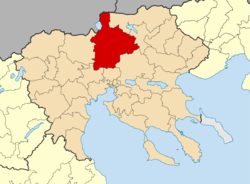Kilkis (city), Greece
|
Kilkis Κιλκίς |
|
|---|---|

Municipality of Kilkis
|
|
| Coordinates: 40°59′N 22°52′E / 40.983°N 22.867°ECoordinates: 40°59′N 22°52′E / 40.983°N 22.867°E | |
| Country | Greece |
| Administrative region | Central Macedonia |
| Regional unit | Kilkis |
| Area | |
| • Municipality | 1,599.6 km2 (617.6 sq mi) |
| • Municipal unit | 319.8 km2 (123.5 sq mi) |
| Elevation | 280 m (920 ft) |
| Population (2011) | |
| • Municipality | 51,926 |
| • Municipality density | 32/km2 (84/sq mi) |
| • Municipal unit | 28,745 |
| • Municipal unit density | 90/km2 (230/sq mi) |
| Community | |
| • Population | 24,274 (2011) |
| Time zone | EET (UTC+2) |
| • Summer (DST) | EEST (UTC+3) |
| Postal code | 611 00 |
| Area code(s) | 23410 |
| Vehicle registration | NI, ΚΙ* |
| Website | www.e-kilkis.gr |
Kilkis (Greek: Κιλκίς, Bulgarian: Кукуш) is an industrial city in Central Macedonia, Greece. As of 2011[update] there were 22,914 people living in the city proper, 28,745 people living in the municipal unit, and 51,926 in the municipality of Kilkis. It is also the capital city of the regional unit of Kilkis.
Kilkis is located in a region that was multi-ethnic in the recent past and is known by several different names. The name of the city in early Byzantine times was Kallikon, and was also known as Kalkis or Kilkis by the Greeks. In church Codix of 1732 it is mentioned as Kilkisi (Κηλκήση). In the South Slavic languages it is known as Kukush (Кукуш, Kukuš), while it was called Kilkitsi or Kılkış by the Ottoman Turks.
The municipality Kilkis was formed at the 2011 local government reform by the merger of the following 7 former municipalities, that became municipal units:
The municipality has an area of 1,599.604 km2, the municipal unit 319.834 km2.
The municipal unit Kilkis consists of the following communities (settlements):
The province of Kilkis (Greek: Επαρχία Κιλκίς) was one of the provinces of the Kilkis Prefecture. Its territory corresponded with that of the current municipality Kilkis, and the municipal unit Polykastro. It was abolished in 2006.
Findings dating back to as early as the Bronze and Iron Age have been excavated in the vicinity of Kilkis, including ancient tombs of the 2nd millennium BC. In classical antiquity, the wider region of Kilkis was ruled by the kingdom of Macedon. At the time, Kilkis was in the center of a region called Krestonia. When Phillip II of Macedon visited Krestonia, the locals offered him olives from Krestonia valley, something that he had never eaten before. At that time, many towns flourished in the region, such as Idomeni, Atalanti (Axioupoli nowadays), Gortynia (Gorgopi nowadays), Planitsa (Fyska nowadays), Terpillos, Klitae (Xylokeratia nowadays), Vragylos (Metalliko nowadays), Ioron (Palatiano nowadays), Chaetae (Tsaousitsa nowadays), Carabia (Limnotopos nowadays), Bairos (Kastro nowadays), Morrylos (Ano Apostoli nowadays), Doveros (Doirani nowadays), Evropos and Kallindria.
...
Wikipedia


